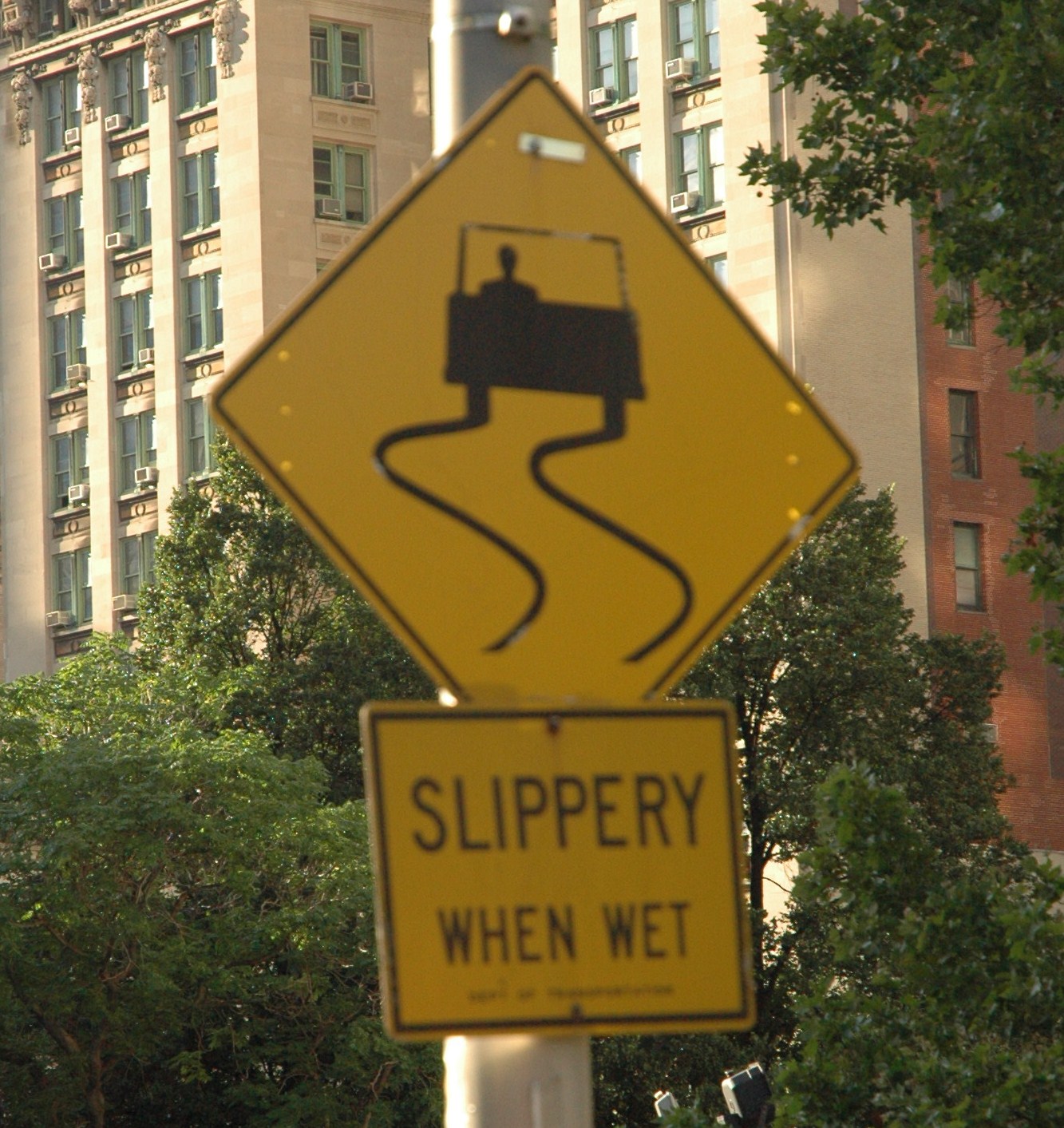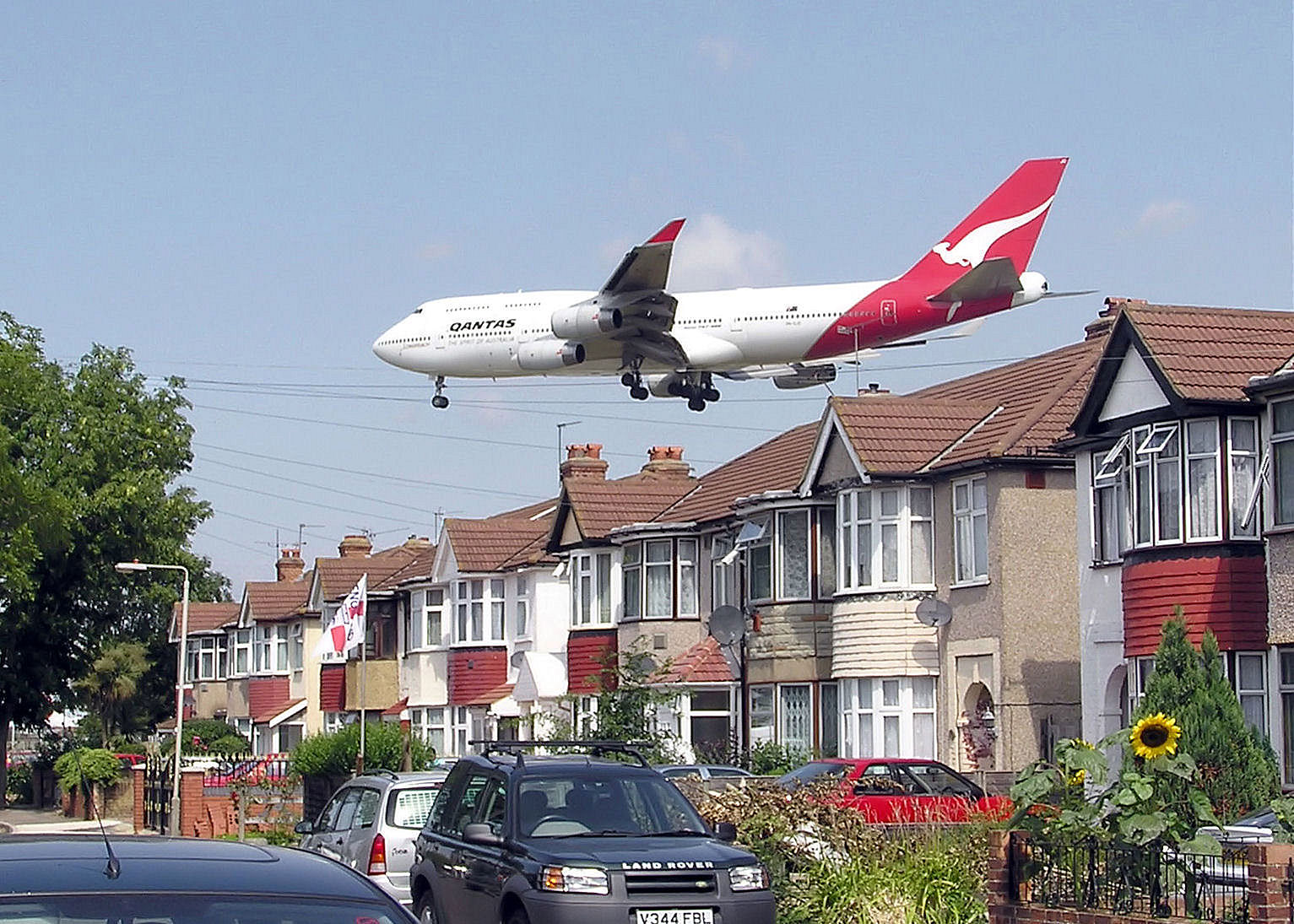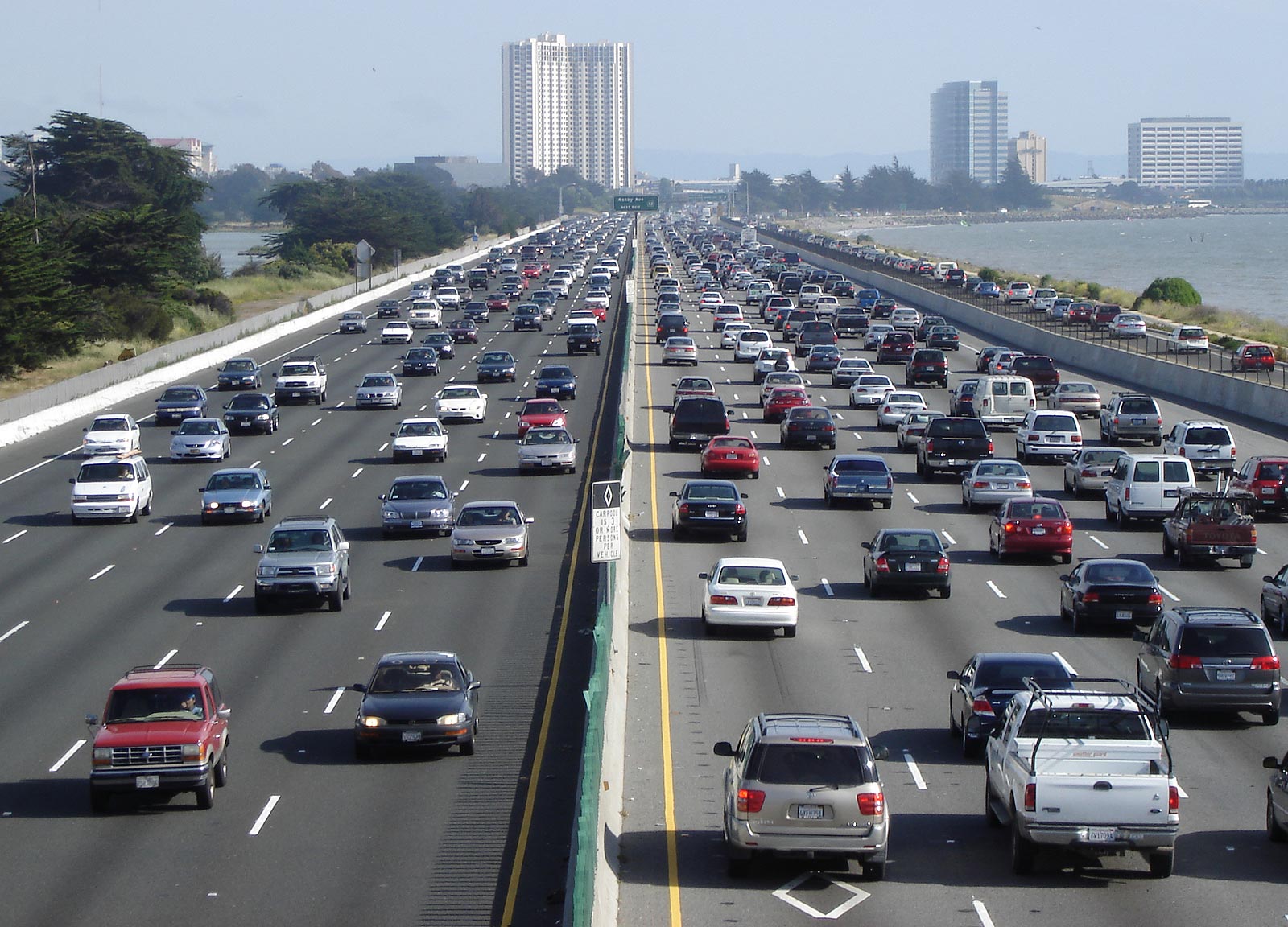|
Sliding (motion)
Sliding is a type of frictional motion between two surfaces in contact. This can be contrasted to rolling motion. Both types of motion may occur in bearings. The relative motion or tendency toward such motion between two surfaces is resisted by friction. Friction may damage or 'wear' the surfaces in contact. However, wear can be reduced by lubrication. The science and technology of friction, lubrication, and wear is known as tribology. Sliding may occur between two objects of arbitrary shape, whereas rolling friction is the frictional force associated with the rotational movement of a somewhat disclike or other circular object along a surface. Generally, the frictional force of rolling friction is less than that associated with sliding kinetic friction. Typical values for the coefficient of rolling friction are less than that of sliding friction. Correspondingly sliding friction typically produces greater sound and thermal bi-products. One of the most common examples of sl ... [...More Info...] [...Related Items...] OR: [Wikipedia] [Google] [Baidu] |
Rolling
Rolling is a type of motion that combines rotation (commonly, of an axially symmetric object) and translation of that object with respect to a surface (either one or the other moves), such that, if ideal conditions exist, the two are in contact with each other without sliding. Rolling where there is no sliding is referred to as ''pure rolling''. By definition, there is no sliding when there is a frame of reference in which all points of contact on the rolling object have the same velocity as their counterparts on the surface on which the object rolls; in particular, for a frame of reference in which the rolling plane is at rest (see animation), the instantaneous velocity of all the points of contact (e.g., a generating line segment of a cylinder) of the rolling object is zero. In practice, due to small deformations near the contact area, some sliding and energy dissipation occurs. Nevertheless, the resulting rolling resistance is much lower than sliding friction, and thus, roll ... [...More Info...] [...Related Items...] OR: [Wikipedia] [Google] [Baidu] |
Tire
A tire (American English) or tyre (British English) is a ring-shaped component that surrounds a Rim (wheel), wheel's rim to transfer a vehicle's load from the axle through the wheel to the ground and to provide Traction (engineering), traction on the surface over which the wheel travels. Most tires, such as those for automobiles and bicycles, are pneumatically inflated structures, which also provide a flexible cushion that absorbs shock as the tire rolls over rough features on the surface. Tires provide a footprint, called a contact patch, that is designed to match the weight of the vehicle with the bearing strength of the surface that it rolls over by providing a bearing pressure that will not deform the surface excessively. The materials of modern pneumatic tires are synthetic rubber, natural rubber, fabric, and wire, along with carbon black and other chemical compounds. They consist of a tire tread, tread and a body. The tread provides Traction (engineering), traction ... [...More Info...] [...Related Items...] OR: [Wikipedia] [Google] [Baidu] |
Slippery When Wet NYC
Slipperiness is when a surface has a low coefficient of friction, allowing objects to glide across the surface. People walking on slippery surfaces are likely to slip or fall. A surface can for example be slippery due to it being wet, or due to it being icy. There are several competing theories about why ice is slippery. Road slipperiness is a major area of road safety, but various means have also been developed to measure walkway and deck slipperiness in order to develop health and safety standards.Wen-Ruey Chang, Theodore K. Courtney, Raoul Grongvist ''Measuring Slipperiness: Human Locomotion and Surface Factors'' 2002 0415298288 "A number of 'purely' subjective approaches (e.g. paired comparisons) have been applied to measure slipperiness. Human subjects seem to be capable of differentiating the slipperiness of floors (Yoshioka et al. 1978, 1979, Swensen et al." See also *Floor slip resistance testing *Ice cleats Ice cleats are a contraption, affixed to a shoe or boot, ... [...More Info...] [...Related Items...] OR: [Wikipedia] [Google] [Baidu] |
Normal Force
In mechanics, the normal force F_n is the component of a contact force that is perpendicular to the surface that an object contacts, as in Figure 1. In this instance ''normal'' is used in the geometric sense and means perpendicular, as opposed to the common language use of ''normal'' meaning "ordinary" or "expected". A person standing still on a platform is acted upon by gravity, which would pull them down towards the Earth's core unless there were a countervailing force from the resistance of the platform's molecules, a force which is named the "normal force". The normal force is one type of ground reaction force. If the person stands on a slope and does not sink into the ground or slide downhill, the total ground reaction force can be divided into two components: a normal force perpendicular to the ground and a frictional force parallel to the ground. In another common situation, if an object hits a surface with some speed, and the surface can withstand the impact, the nor ... [...More Info...] [...Related Items...] OR: [Wikipedia] [Google] [Baidu] |
Contact Force
A contact force is any force that occurs as a result of two objects making contact with each other. Contact forces are ubiquitous and are responsible for most visible interactions between macroscopic collections of matter. Pushing a car or kicking a ball are some of the everyday examples where contact forces are at work. In the first case the force is continuously applied to the car by a person, while in the second case the force is delivered in a short impulse. Contact forces are often decomposed into orthogonal components, one perpendicular to the surface(s) in contact called the normal force, and one parallel to the surface(s) in contact, called the friction force. Not all forces are contact forces; for example, the weight of an object is the force between the object and the Earth, even though the two do not need to make contact. Gravitational forces, electrical forces and magnetic forces are body forces and can exist without contact occurring. Origin of contact forces The m ... [...More Info...] [...Related Items...] OR: [Wikipedia] [Google] [Baidu] |
Noise Pollution
Noise pollution, also known as environmental noise or sound pollution, is the propagation of noise with ranging impacts on the activity of human or animal life, most of them are harmful to a degree. The source of outdoor noise worldwide is mainly caused by machines, transport, and propagation systems.Senate Public Works Committee. ''Noise Pollution and Abatement Act of 1972''. S. Rep. No. 1160, 92nd Congress. 2nd session Poor urban planning may give rise to noise disintegration or pollution, side-by-side industrial and residential buildings can result in noise pollution in the residential areas. Some of the main sources of noise in residential areas include loud music, transportation (traffic, rail, airplanes, etc.), lawn care maintenance, construction, electrical generators, wind turbines, explosions, and people. Documented problems associated with noise in urban environments go back as far as ancient Rome. Research suggests that noise pollution in the United States is the high ... [...More Info...] [...Related Items...] OR: [Wikipedia] [Google] [Baidu] |
Roadway Noise
Roadway noise is the collective sound energy emanating from motor vehicles. It consists chiefly of road surface, tire, engine/transmission, aerodynamic, and braking elements. Noise of rolling tires driving on pavement is found to be the biggest contributor of highway noise and increases with higher vehicle speeds. In developed and developing countries, roadway noise contributes a proportionately large share of the total societal noise pollution. In the U.S., it contributes more to environmental noise exposure than any other noise source. History Roadway noise began to be measured in a widespread manner in the 1960s, as computer modeling of this phenomenon began to become meaningful. After passage of the National Environmental Policy Act and Noise Control Act, the demand for detailed analysis soared, and decision makers began to look to acoustical scientists for answers regarding the planning of new roadways and the design of noise mitigation. Partial bans on motor vehic ... [...More Info...] [...Related Items...] OR: [Wikipedia] [Google] [Baidu] |
Roadway
A carriageway (British English) or roadway (North American English) consists of a width of road on which a vehicle is not restricted by any physical barriers or separation to move laterally. A carriageway generally consists of a number of traffic lanes together with any associated shoulder, but may be a sole lane in width (for example, a highway offramp). Description A single carriageway road (North American English: undivided highway) has one carriageway with 1, 2 or more lanes together with any associated footways (North American English: sidewalk) and road verges (North American English: tree belt). A dual carriageway road (North American English: divided highway) has two roadways separated by a central reservation (North American English: median). A local-express lane system (also called collector-express or collector-distributor) has more than two roadways, typically two sets of 'local lanes' or 'collector lanes' and also two sets of 'express lanes'. "Cars only" lane ... [...More Info...] [...Related Items...] OR: [Wikipedia] [Google] [Baidu] |
Motor Vehicle
A motor vehicle, also known as motorized vehicle or automotive vehicle, is a self-propelled land vehicle, commonly wheeled, that does not operate on Track (rail transport), rails (such as trains or trams) and is used for the transportation of people or cargo. The vehicle propulsion is provided by an engine or motor, usually an internal combustion engine or an electric motor, or some combination of the two, such as hybrid electric vehicles and plug-in hybrids. For legal purpose, motor vehicles are often identified within a number of vehicle classes including cars, buses, motorcycles, off-road vehicles, light trucks and regular trucks. These classifications vary according to the legal codes of each country. International Organization for Standardization, ISO 3833:1977 is the standard for road vehicle types, terms and definitions. Generally, to avoid requiring people with disabilities from having to possess an operator's license to use one, or requiring tags and insurance, powered ... [...More Info...] [...Related Items...] OR: [Wikipedia] [Google] [Baidu] |
Bearing (mechanical)
A bearing is a machine element that constrains relative motion to only the desired motion, and reduces friction between moving parts. The design of the bearing may, for example, provide for free linear movement of the moving part or for free rotation around a fixed axis; or, it may ''prevent'' a motion by controlling the vectors of normal forces that bear on the moving parts. Most bearings facilitate the desired motion by minimizing friction. Bearings are classified broadly according to the type of operation, the motions allowed, or to the directions of the loads (forces) applied to the parts. Rotary bearings hold rotating components such as shafts or axles within mechanical systems, and transfer axial and radial loads from the source of the load to the structure supporting it. The simplest form of bearing, the ''plain bearing'', consists of a shaft rotating in a hole. Lubrication is used to reduce friction. In the ''ball bearing'' and ''roller bearing'', to reduce sliding ... [...More Info...] [...Related Items...] OR: [Wikipedia] [Google] [Baidu] |
Braking
A brake is a mechanical device that inhibits motion by absorbing energy from a moving system. It is used for slowing or stopping a moving vehicle, wheel, axle, or to prevent its motion, most often accomplished by means of friction. Background Most brakes commonly use friction between two surfaces pressed together to convert the kinetic energy of the moving object into heat, though other methods of energy conversion may be employed. For example, regenerative braking converts much of the energy to electrical energy, which may be stored for later use. Other methods convert kinetic energy into potential energy in such stored forms as pressurized air or pressurized oil. Eddy current brakes use magnetic fields to convert kinetic energy into electric current in the brake disc, fin, or rail, which is converted into heat. Still other braking methods even transform kinetic energy into different forms, for example by transferring the energy to a rotating flywheel. Brakes are generally ... [...More Info...] [...Related Items...] OR: [Wikipedia] [Google] [Baidu] |



_in_1890_09.jpg)




